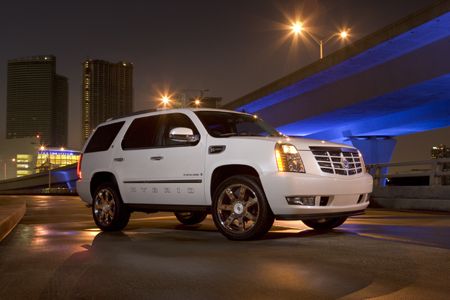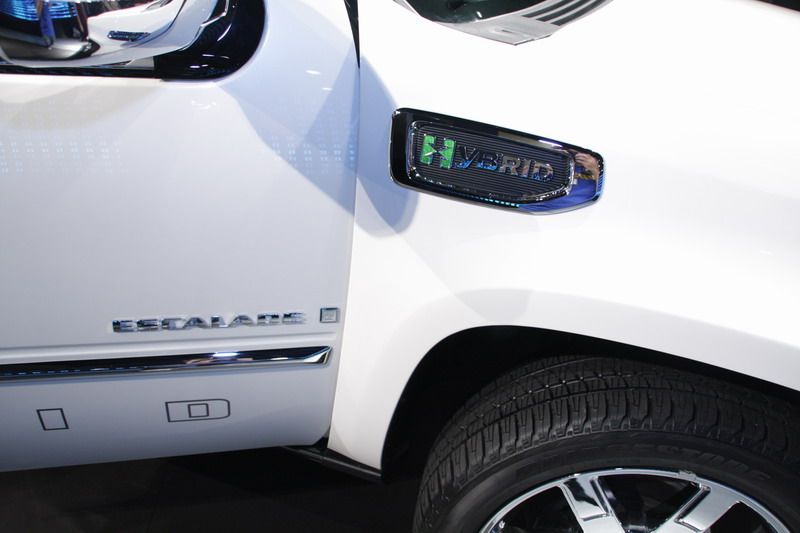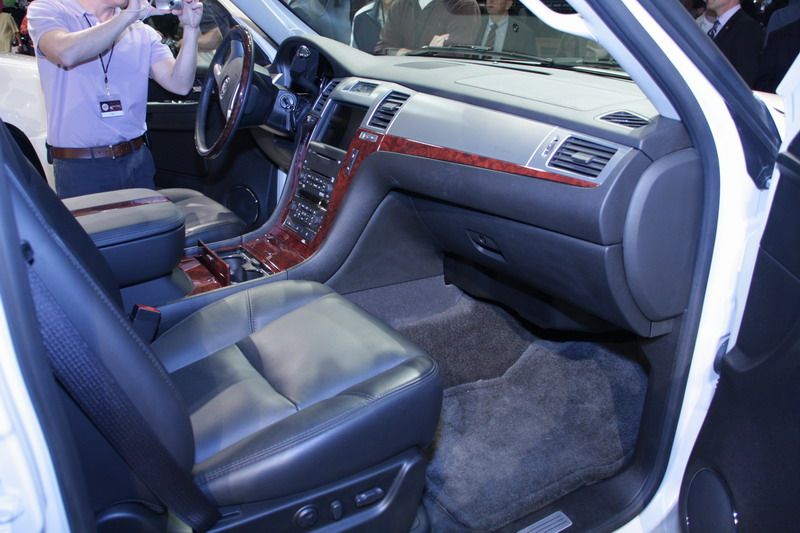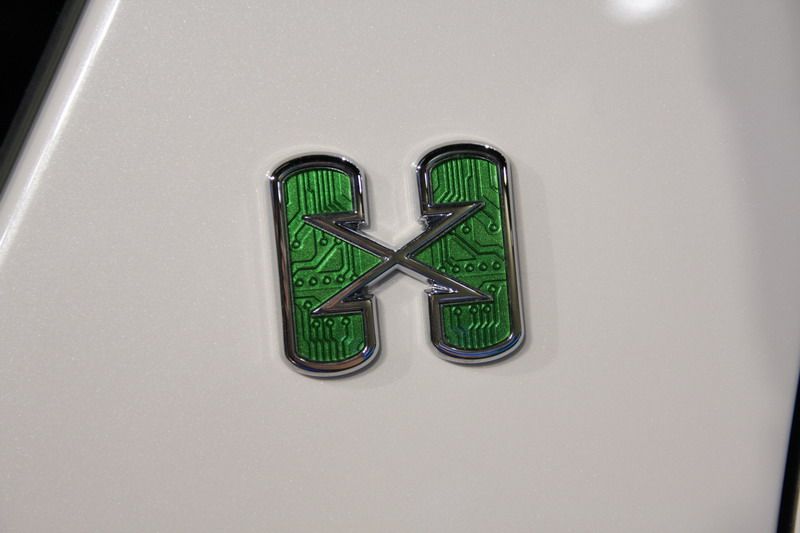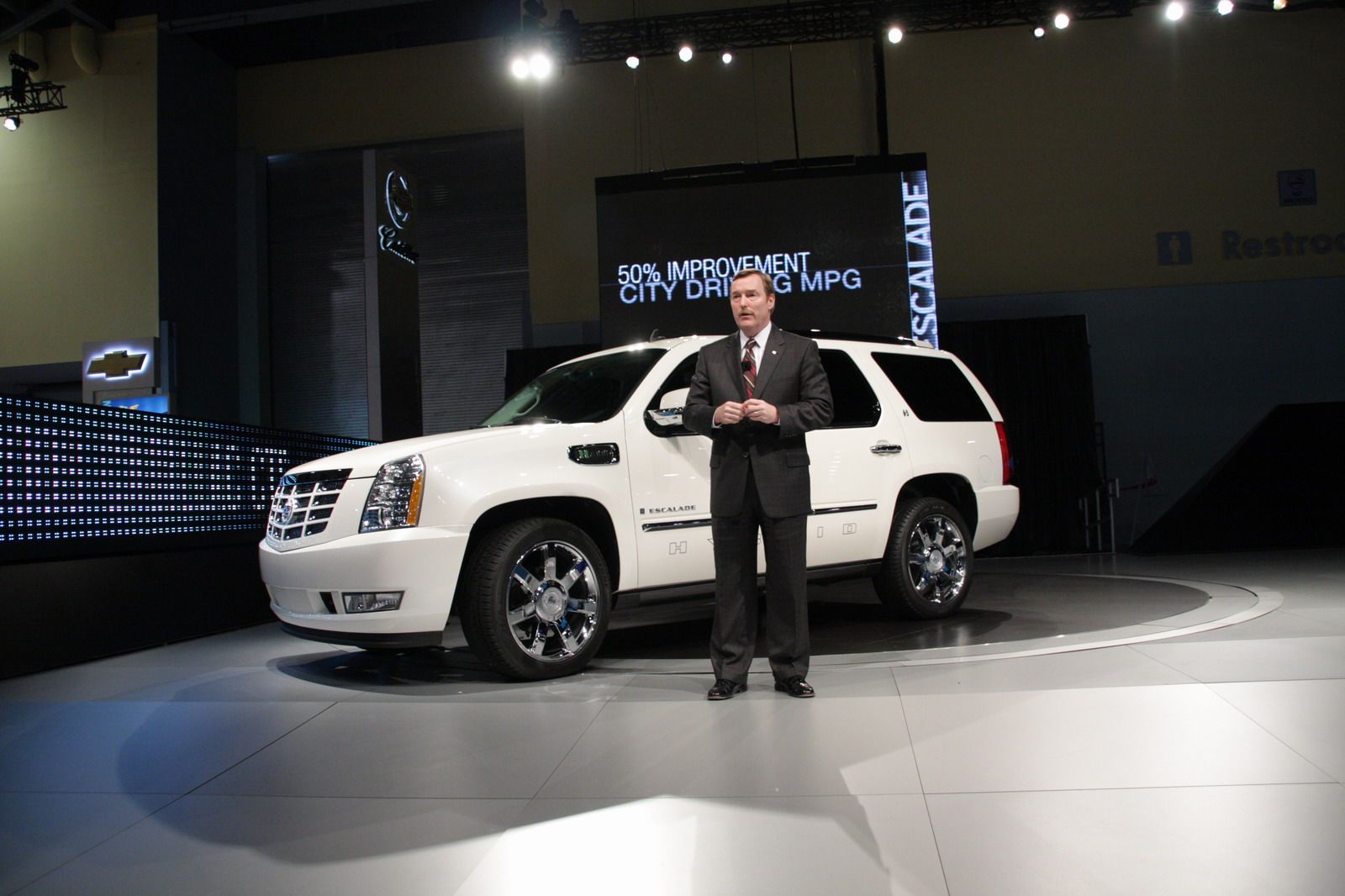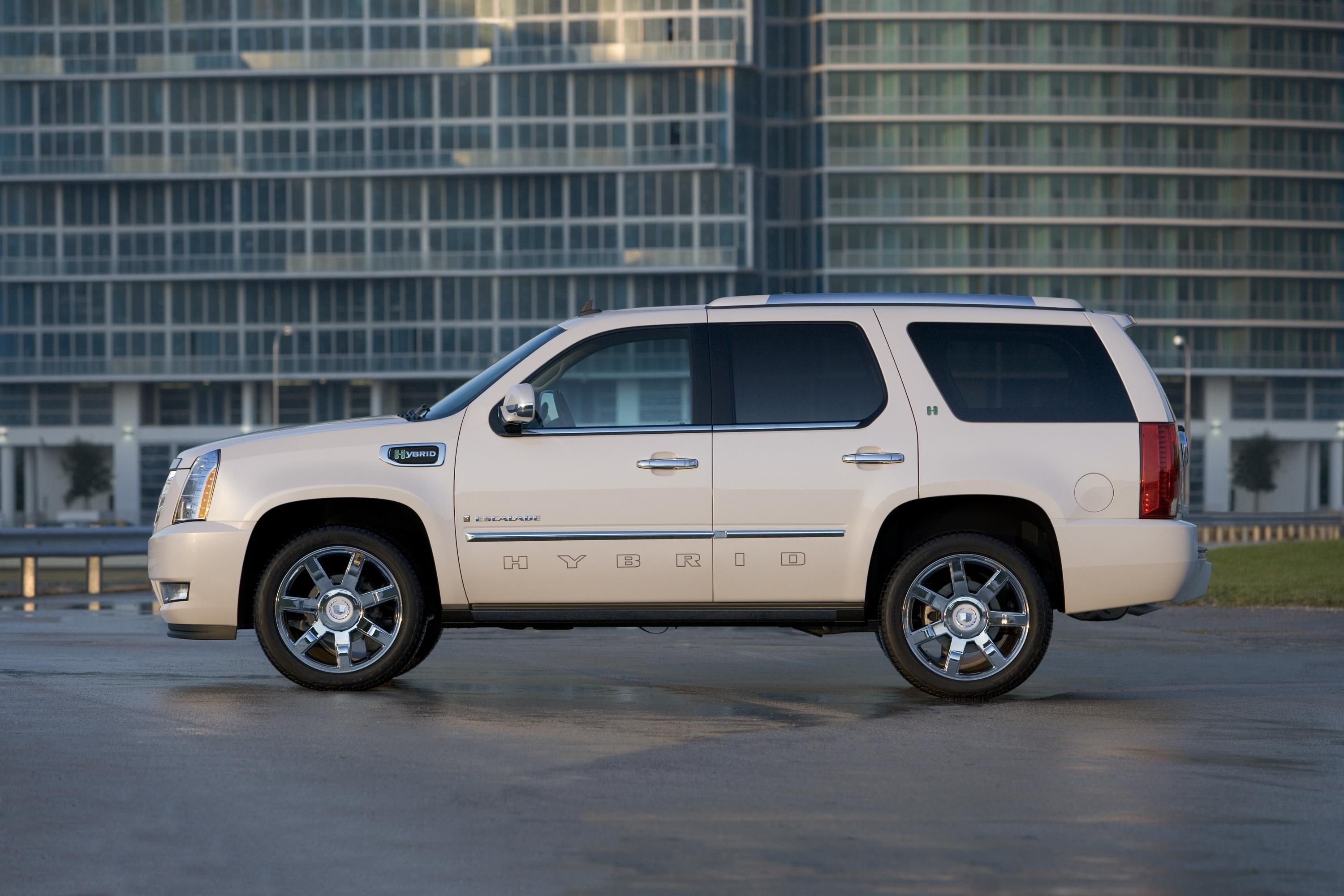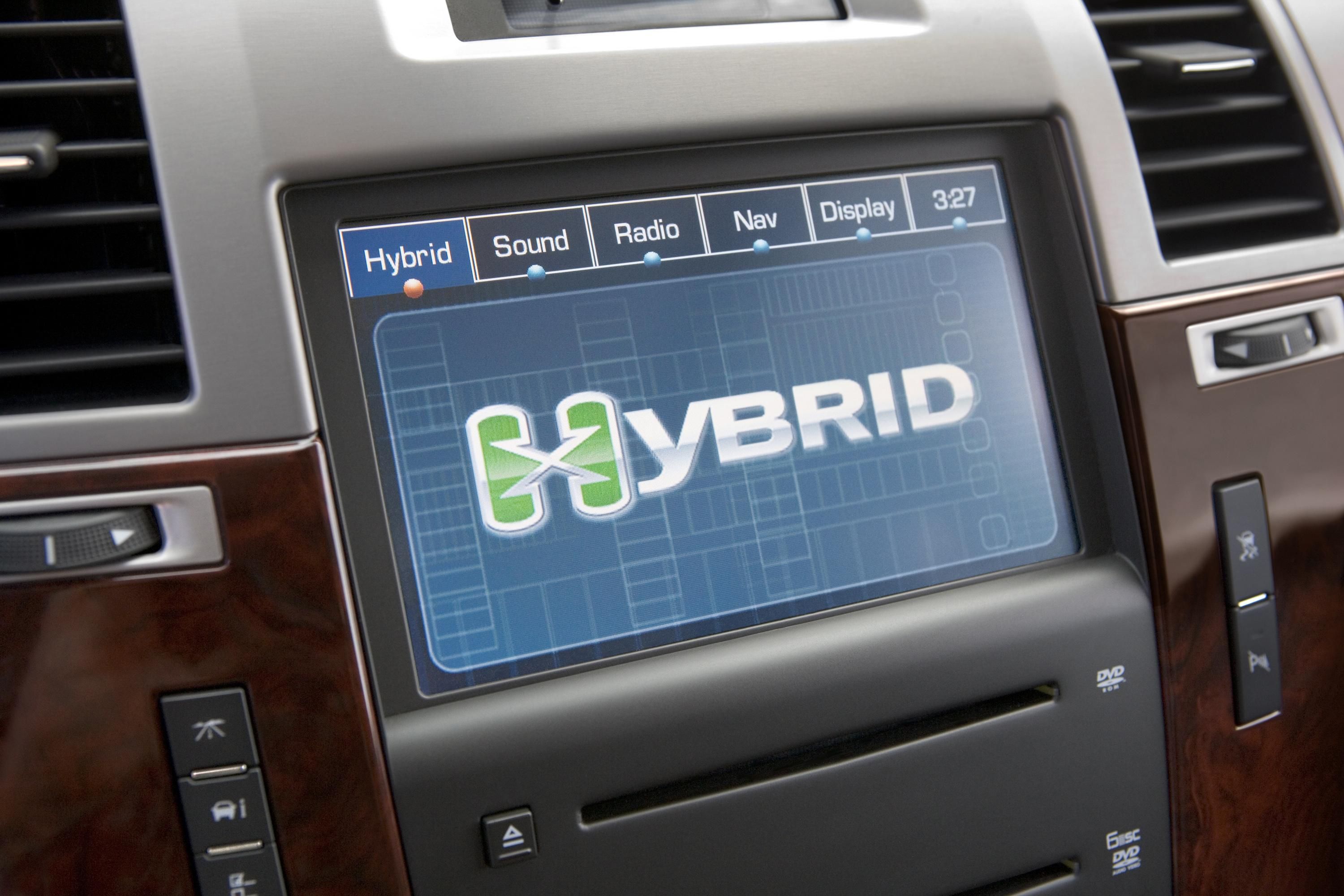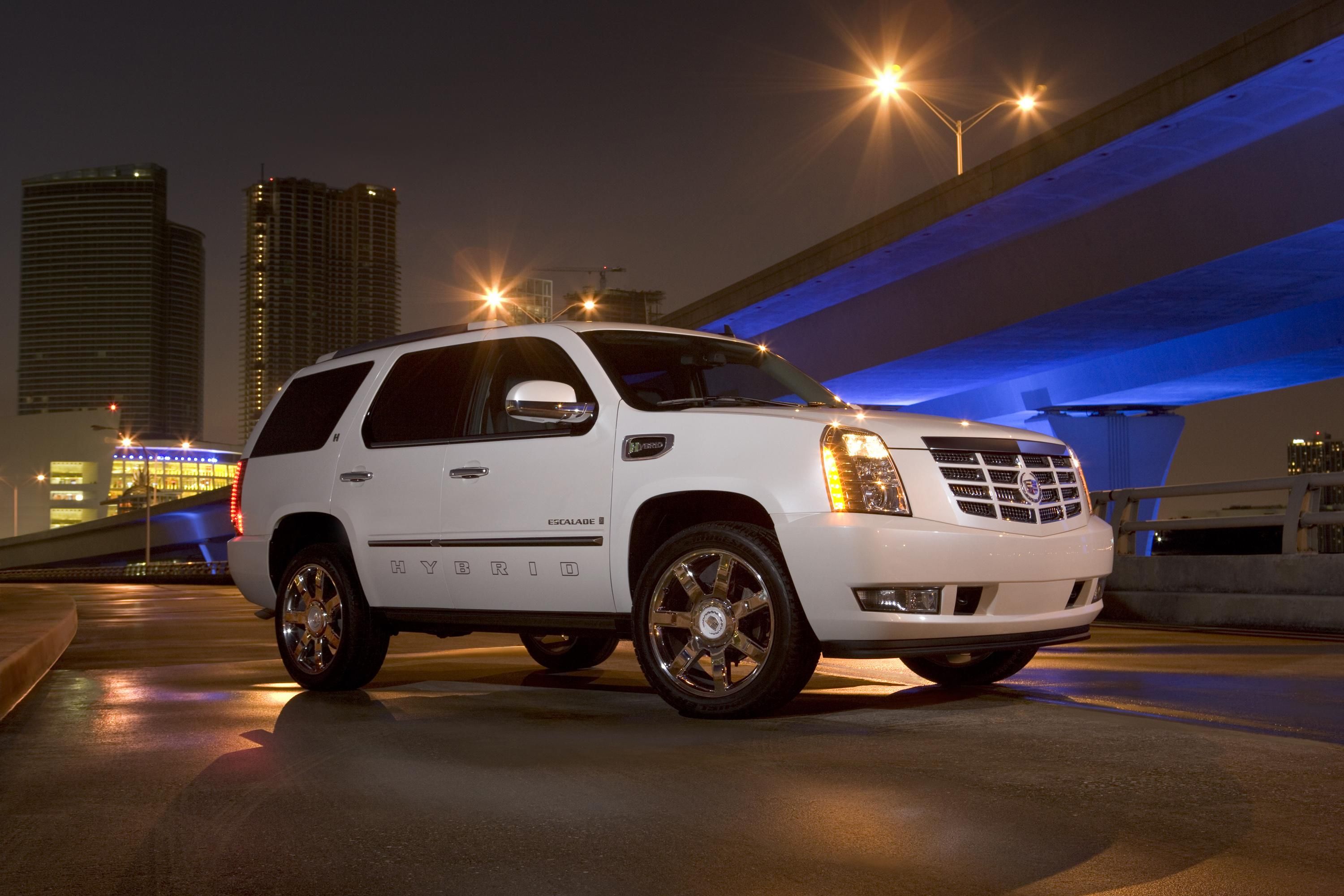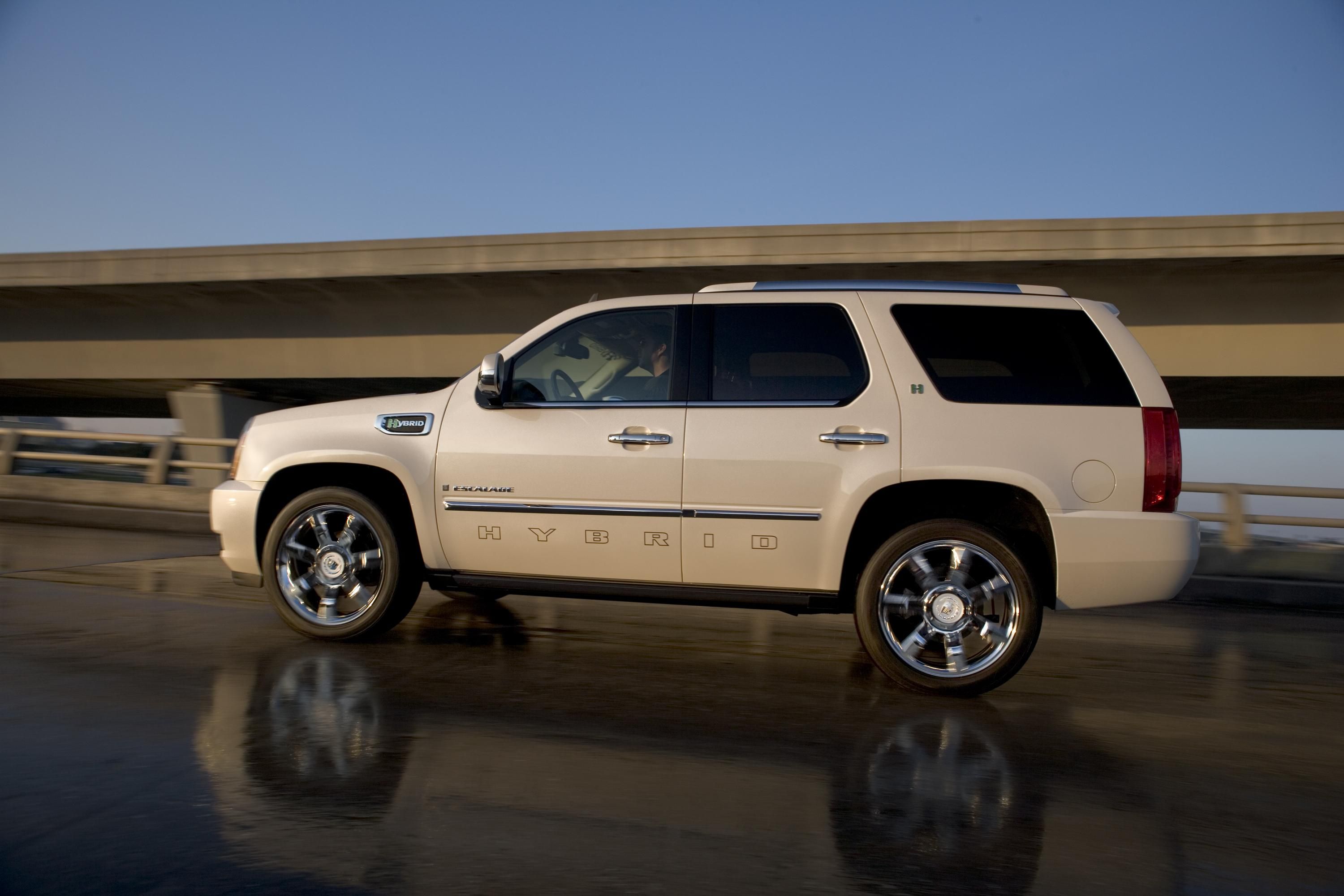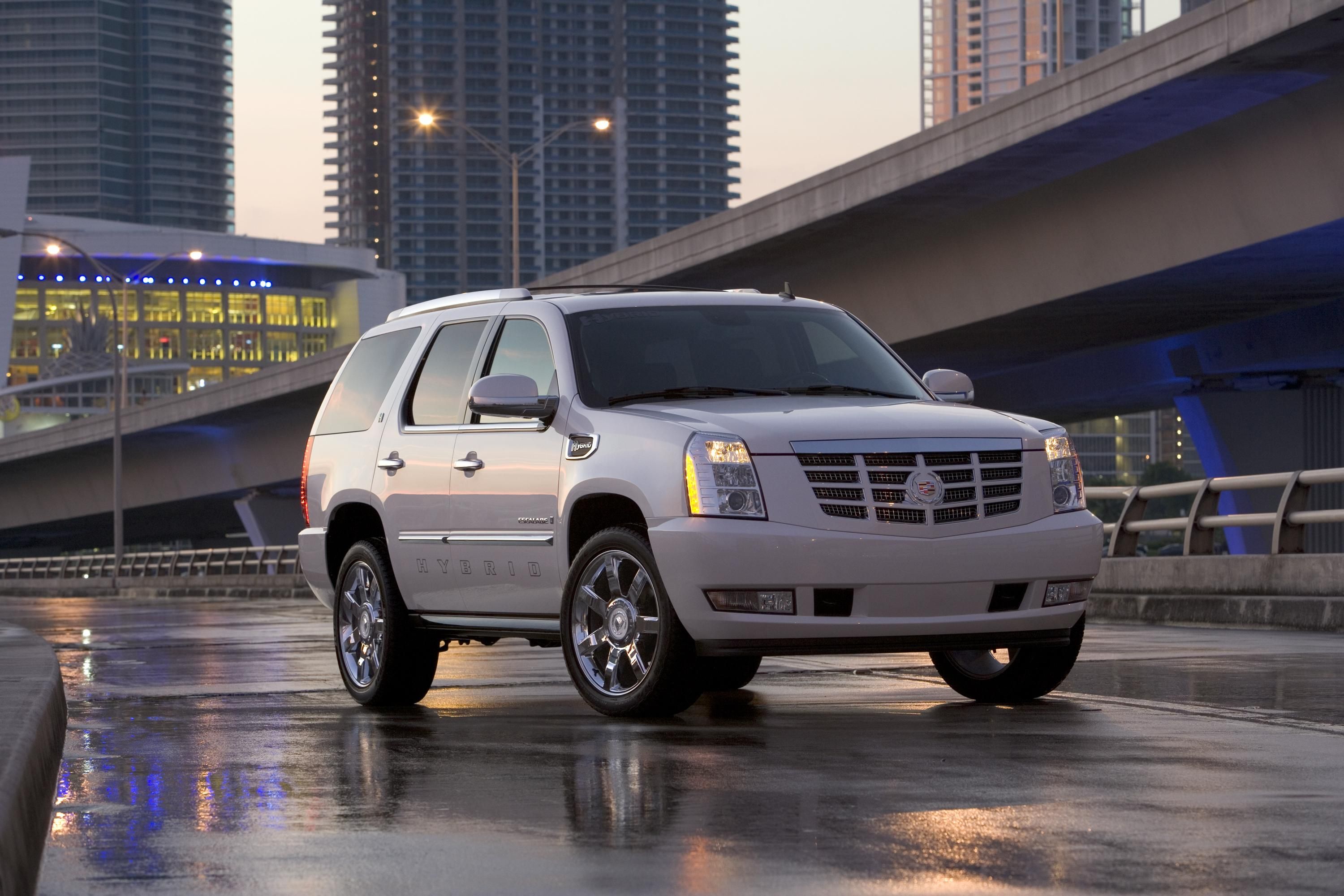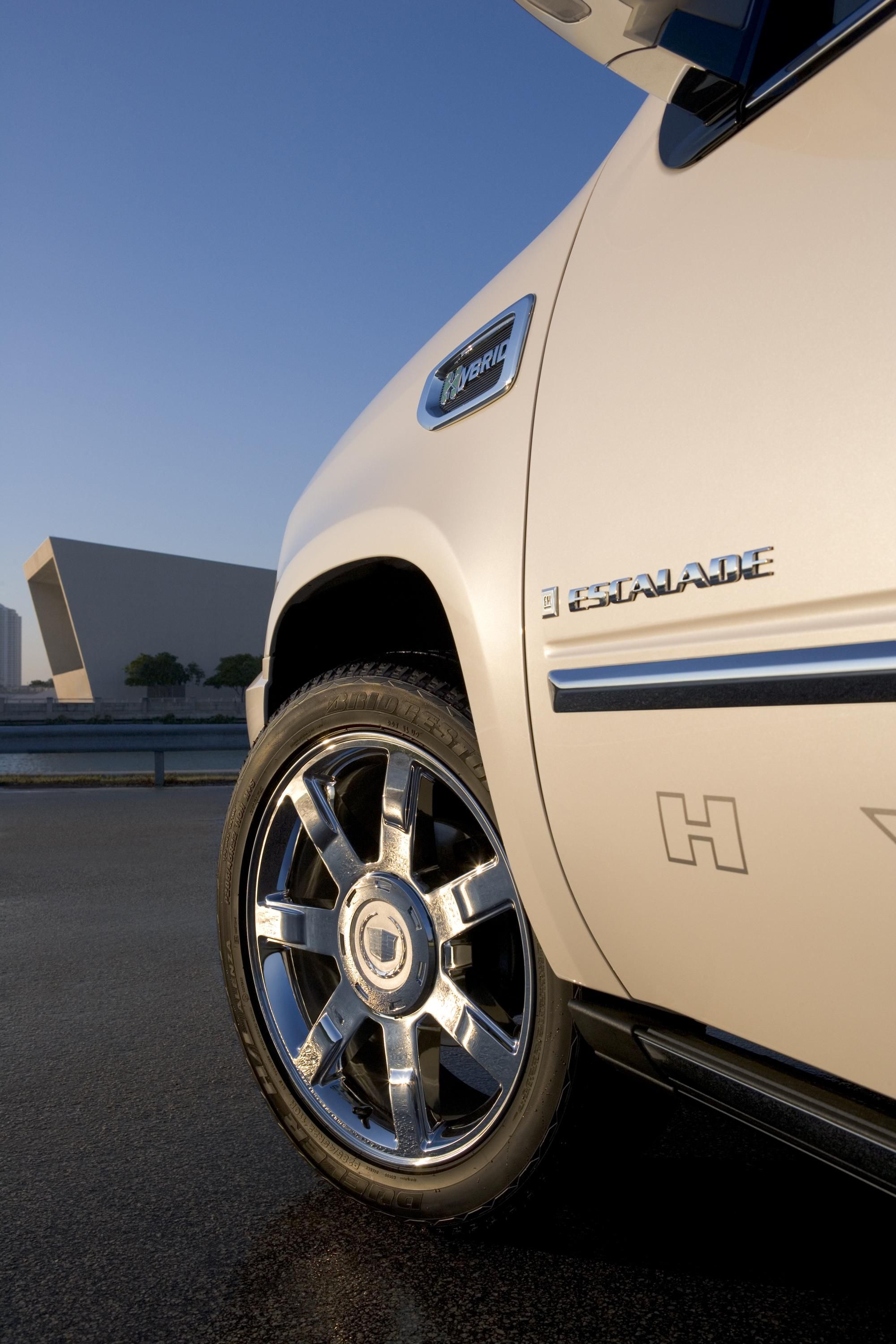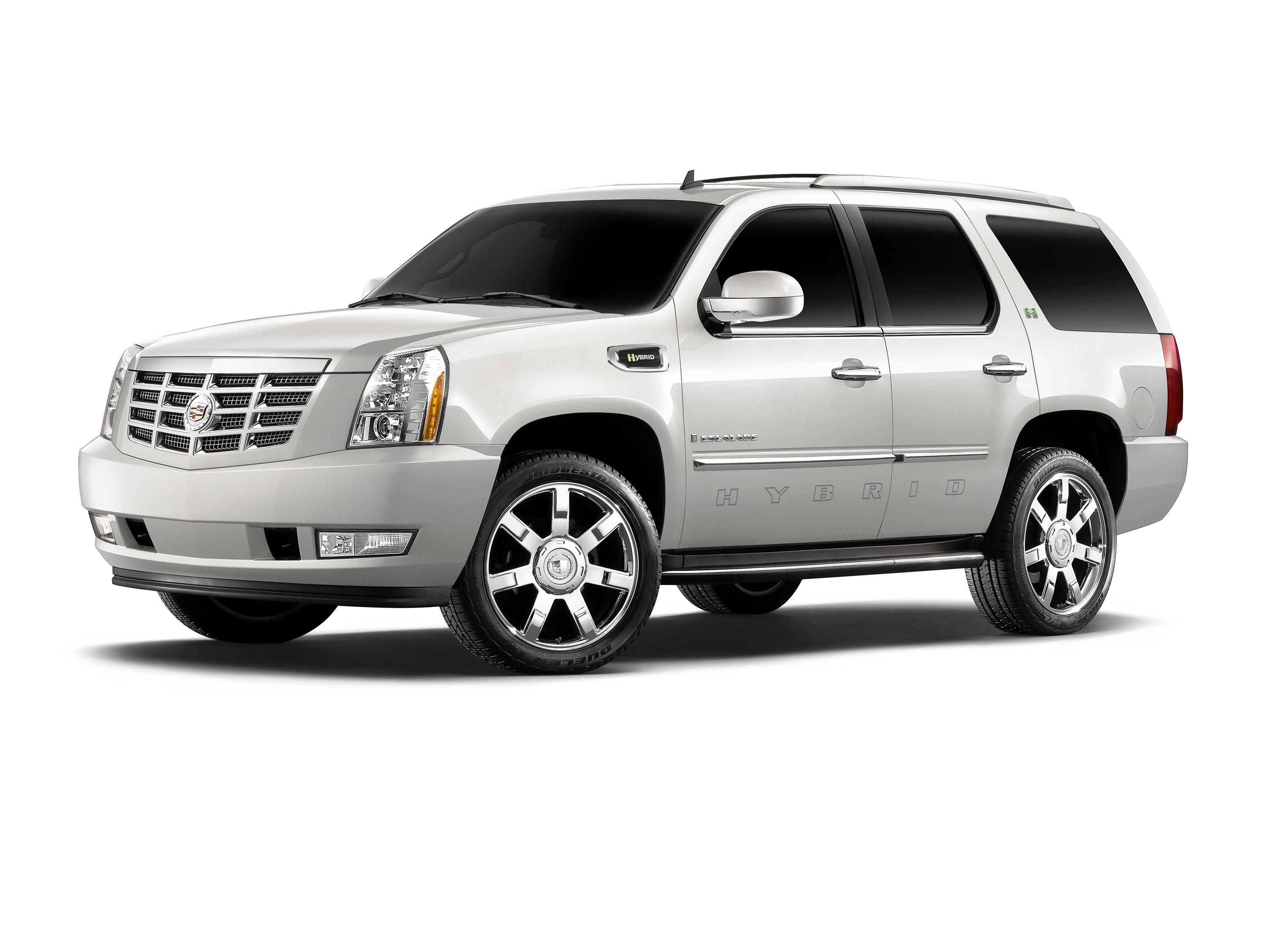Cadillac announced the world premiere of the Escalade Hybrid, the world’s first fuel-saving hybrid applied to a large luxury SUV. Powered by an innovative, fuel-saving 2-Mode Hybrid system, Escalade Hybrid will deliver more than a 50-percent improvement in fuel economy in city driving – all while delivering the same distinctive style, segment-leading features and full-size capability that have made the Escalade an icon.
2009 Cadillac Escalade Hybrid
- Make: Array
- Model: 2009 Cadillac Escalade Hybrid
- Engine/Motor: V8
- [do not use] Vehicle Model: Array
2008 - 2010 Dodge Viper SRT10 ACR
- Make: Array
- Model: 2008 - 2010 Dodge Viper SRT10 ACR
- Engine/Motor: aluminum V-10
- Horsepower: 600 HP
- Torque: 560 lb-ft
- Transmission: Tremec T56 six-speed manual transmission
- [do not use] Vehicle Model: Array
“ Escalade, already the sales and style leader among large luxury SUVs, now adds the desirability of a fuel-saving, technically advanced hybrid system,” said Jim Taylor, Cadillac general manager. “The arrival of Escalade Hybrid means that consumers can now use less fossil fuel, reduce emissions and still enjoy the benefits of a full-size luxury SUV.”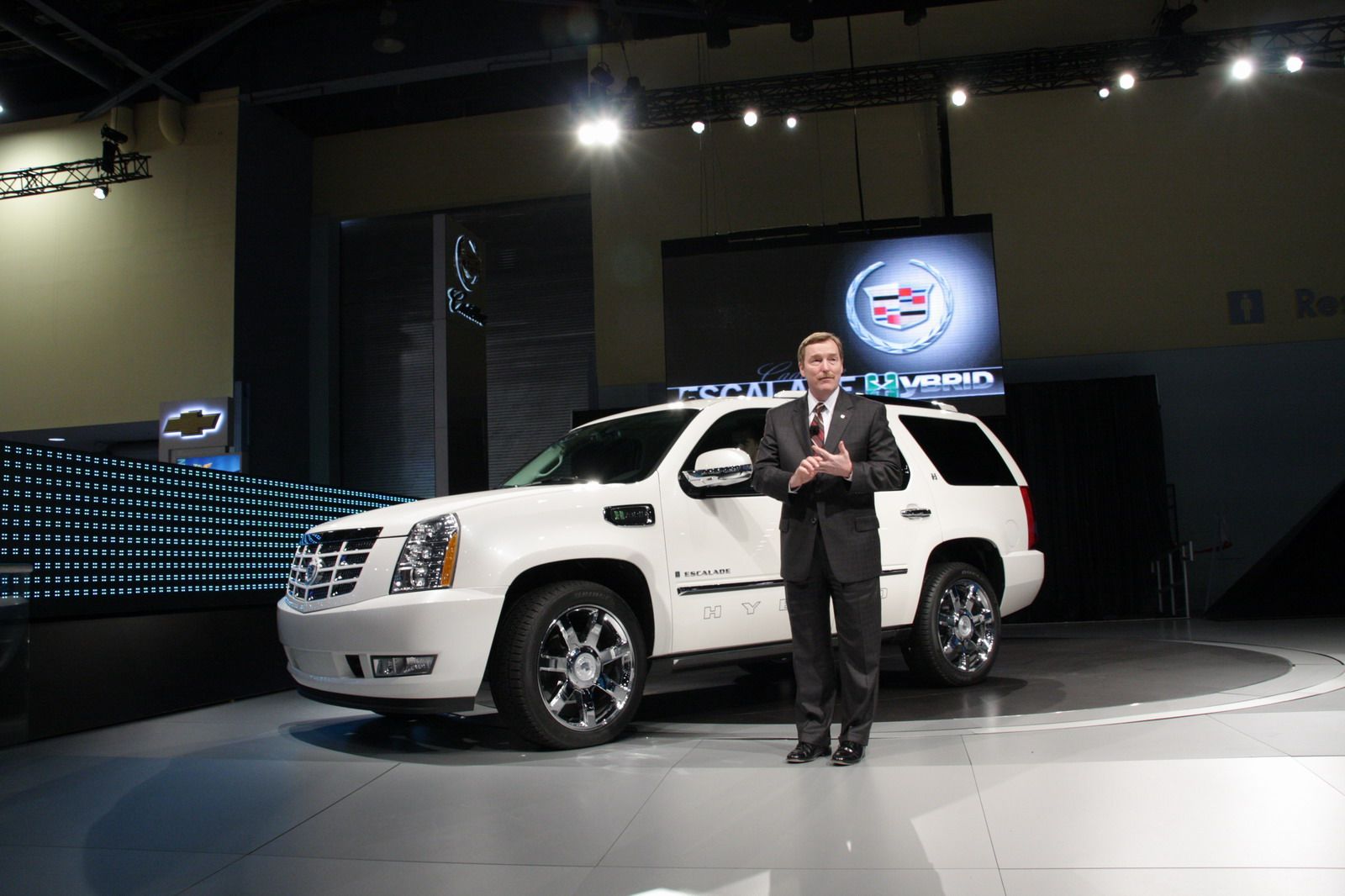
The Hybrid goes on sale in the summer of 2008 and is the newest example of Escalade’s technology leadership.
“No other manufacturer offers a hybrid than can seat eight luxuriously while simultaneously carrying or trailering lots of cargo comfortably,” Taylor said. “And no hybrid delivers the dramatic presence that is synonymous with Escalade.”
Escalade Hybrid is available in 2WD and 4WD configurations. It delivers up to 6,000 pounds (2,721 kg) of usable towing capacity on 2WD models and 5,700 pounds (2,585 kg) on 4WD models. All of Escalade’s standard comfort and convenience features are included. This includes an eight-inch, touch-screen navigation system that displays performance readouts of the 2-Mode Hybrid system on the screen.
Escalade Hybrid extends Cadillac’s leadership in the large luxury SUV category. Escalade sales have grown in the face of changing sales trends and increased competition. In fact, Escalade sales increased 22 percent in September over year-ago sales. Other models in the Escalade lineup include the extended-length Escalade ESV and the versatile Escalade EXT luxury-utility truck. The Hybrid model is available with the standard Escalade body style.
Patented 2-Mode Hybrid technology
The Escalade’s 2-Mode Hybrid system allows it to return exceptional fuel economy in both city and highway while delivering the capabilities of a true luxury SUV. In city driving, this advanced hybrid power system enables Escalade to launch and drive low speeds on electricity alone. As additional power is demanded, the system blends output from the battery and gas engine smoothly.
GM’s patented 2-Mode Hybrid system consists of an advanced electrically variable transmission (EVT) and 300-volt nickel-metal hydride Energy Storage System (ESS). These systems work in concert with the standard 6.0L V-8 Gen IV gasoline engine with Active Fuel Management (AFM) and late-intake valve closing (LIVC) technology. AFM enables the V-8 engine to seamlessly shut off half of its cylinders when less power is needed, such as during highway cruising. This new hybrid system not only enables the Escalade Hybrid to drive low speeds on electricity alone, it also allows the 6.0L V-8 engine to operate in its more economical four-cylinder mode for longer periods.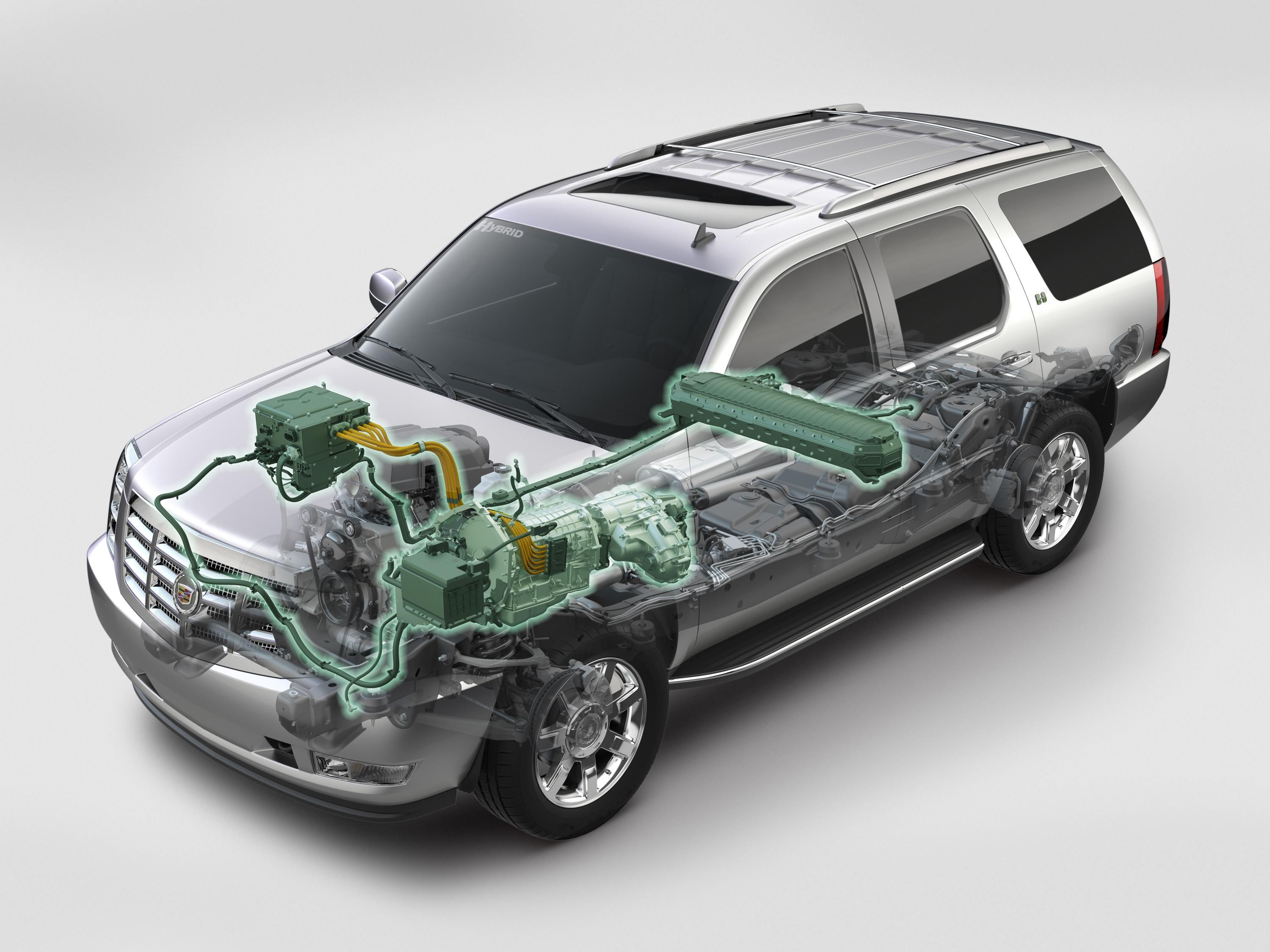 The key to Escalade’s 2-Mode hybrid system is that the electric power used to propel the vehicle is generated by the hybrid system itself. When the brakes are applied or the vehicle is coasting, the electric motors within the hybrid system create electricity that is stored in the 300-volt battery. This stored energy is used to move the vehicle and the regenerative braking cycle is renewed.
The key to Escalade’s 2-Mode hybrid system is that the electric power used to propel the vehicle is generated by the hybrid system itself. When the brakes are applied or the vehicle is coasting, the electric motors within the hybrid system create electricity that is stored in the 300-volt battery. This stored energy is used to move the vehicle and the regenerative braking cycle is renewed.
The 2-Mode Hybrid system provides seamless, dependable power on demand in an efficient package. In fact, its electric motor is less than half the size of those in single-mode hybrid systems. This technology was developed and is still used in fleets of hybrid transit buses on the streets today in dozens of major North American cities. Scaled-down for use in full-size SUVs, the 2-Mode system delivers fuel savings where it is needed most – in large vehicles with high levels of capability. It is a core part of GM’s energy diversity efforts, which are centered on reducing dependence on petroleum, improving fuel economy, reducing emissions and minimizing the automobile’s impact on the environment.
Cadillac’s smooth and quiet power
Acoustic details specific to the Hybrid model ensure it delivers the superior luxury that has been an Escalade hallmark since its inception. The details include:
- A new exhaust system and resonator specially tuned for the 6.0L LIVC engine’s Active Fuel Management operation. It ensures comfortable interior acoustics and a pleasant exhaust note during both V-4 and V-8 operation
- An electrically driven, 300-volt air conditioning compressor reduces vibration and allows the HVAC system to cool the passenger compartment even when the gasoline engine is shut off. It includes the standard tri-zone climate system
- An electrically driven, 42-volt variable-assist power steering reduces vibration and provides up to a 0.5-mpg fuel economy improvement by reducing parasitic losses common in belt-driven hydraulic systems
- The Energy Storage System cooling system’s internal fan is tuned to be quiet at low vehicle speeds, when the fan could more easily be heard by the occupants.
Escalade aesthetic
The Escalade Hybrid retains the qualities that have made it the leading large luxury SUV and a standard-bearer of Cadillac’s overall product renaissance. It is instantly identifiable as a Cadillac and incorporates styling cues from the landmark Sixteen concept vehicle, including a detailed signature grille, front fender vent ports and layers of chrome accents.
The Escalade’s warm and inviting interior features a premium layout. It is available in two colors, Ebony and Cashmere. Standard features include a distinctive instrument panel; gauges with white needles and blue light inlays with continuously lit, white-LED backlighting; Nuance leather-covered seats; leather-covered door trim and center console; and a power-assisted rear liftgate that opens and closes with the touch of a button.
-----
Powertrain
The new, 2009 Cadillac Escalade Hybrid delivers greatly improved fuel economy while maintaining the capabilities and amenities expected of a full-size, V-8-powered SUV. This seemingly incompatible duality is enabled by GM’s patented 2-Mode Hybrid system.
The 2-Mode Hybrid system uses a new, electrically variable transmission (EVT) that offers the best of both worlds: fuel economy and real SUV capability. The two modes consist of a continuously variable operation, for low-load driving situations and a fixed-gear operation, for high-load conditions such as towing or highway driving.
“GM’s breakthrough 2-Mode technology is a perfect fit for luxury consumers” said Jim Taylor, Cadillac general manager. “This is fuel-saving innovation, delivered with the capability, desirability and presence that Escalade uniquely possesses.”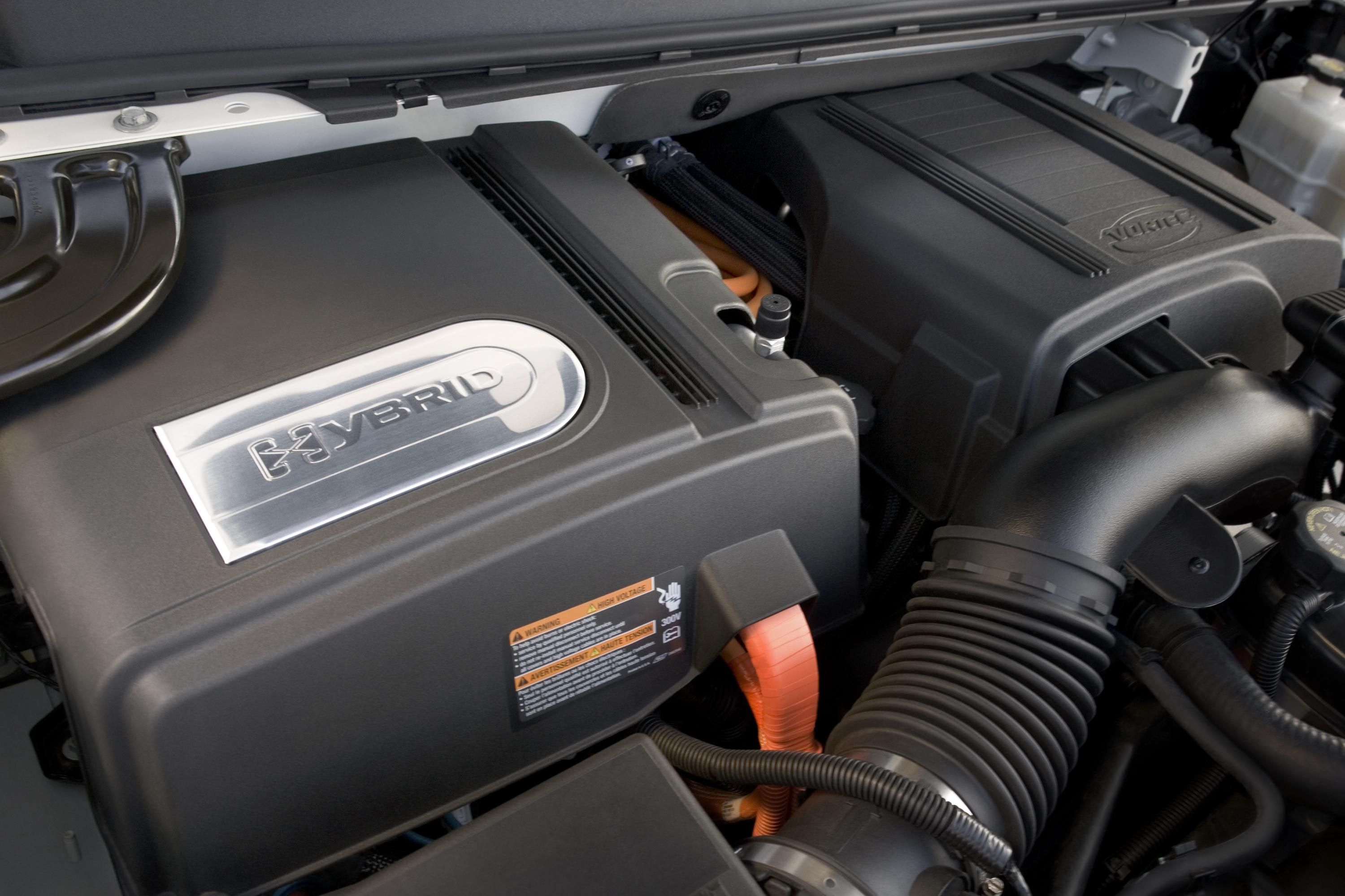 Drawing on experience gleaned in the development of hybrid bus propulsion systems, GM designed the two-mode EVT to provide the best combination of city and highway fuel economy; it is used in concert with the 6.0L Gen IV V-8 engine with Active Fuel Management. Furthermore, the EVT is designed to bolt directly to the standard four-wheel-drive transfer case found on the gasoline-only models for true four-wheel-drive capability.
Drawing on experience gleaned in the development of hybrid bus propulsion systems, GM designed the two-mode EVT to provide the best combination of city and highway fuel economy; it is used in concert with the 6.0L Gen IV V-8 engine with Active Fuel Management. Furthermore, the EVT is designed to bolt directly to the standard four-wheel-drive transfer case found on the gasoline-only models for true four-wheel-drive capability.
The Escalade Hybrid’s drivetrain is made up of the following major components, each of which works together to provide seamless, economical and comfortable operation that goes virtually unnoticed by the driver and passengers:
- Electrically Variable Transmission (EVT)
- Energy Storage System (ESS)
- Vortec 6.0L Gen IV V-8 with Active Fuel Management (AFM) and late-intake valve closing (LIVC)
Electrically Variable Transmission (EVT)
The key to the all-new EVT is its unique assemblage of two 60-kW electric motors, three planetary gear sets and four traditional hydraulic wet clutches. This arrangement allows continuously variable operation, as well as providing four fixed gear ratios (with operation comparable to that of a standard electronically controlled automatic transmission).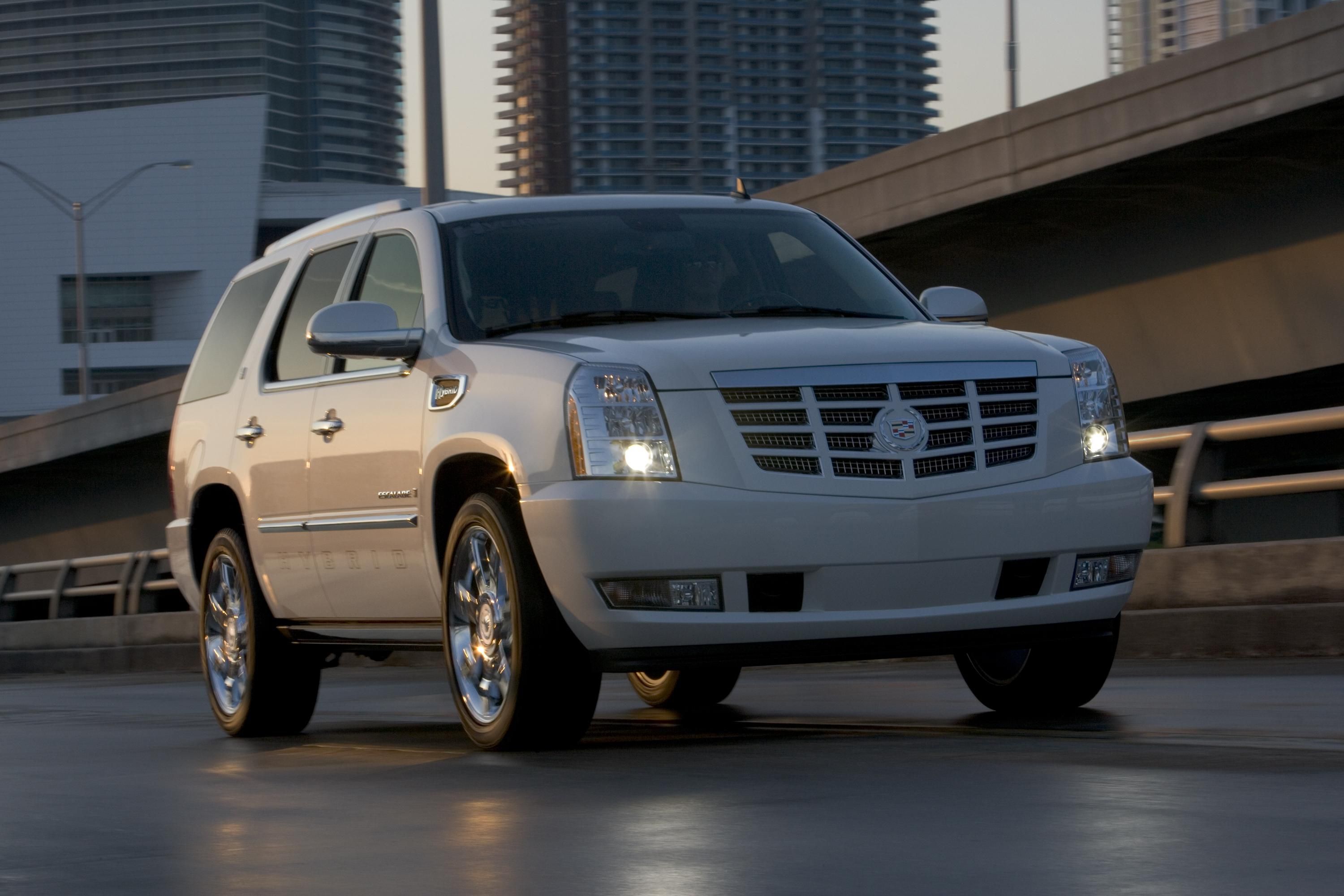 The design was selected because of the operational characteristics of electric motors, which are very efficient at low speeds, but much less efficient as motor rpm increases. GM’s EVT can activate any of its four hydraulic clutches to allow power transfer via the fixed-gear ratios whenever higher load conditions occur. Current hybrid passenger vehicles run their electric motors almost continuously throughout the entire drive cycle, which can be very inefficient under high loads and at highway speeds.
The design was selected because of the operational characteristics of electric motors, which are very efficient at low speeds, but much less efficient as motor rpm increases. GM’s EVT can activate any of its four hydraulic clutches to allow power transfer via the fixed-gear ratios whenever higher load conditions occur. Current hybrid passenger vehicles run their electric motors almost continuously throughout the entire drive cycle, which can be very inefficient under high loads and at highway speeds.
A sophisticated Hybrid Optimizing System (HOS) constantly receives torque-based data from the powertrain and other vehicle systems, and then determines the most efficient means of propelling the vehicle – either via electric power, gasoline engine power or a combination of the two. The EVT is like having two transmissions in one – continuously variable drive for light-load conditions and fixed-ratio drive for high-load situations.
All functions of the EVT are controlled by the HOS, which constantly searches for the optimal transmission operation (using either variable or fixed ratios) to meet current operating conditions. The HOS also bases its decisions on allowing the Vortec 6.0L V-8 to take full advantage of its Active Fuel Management system and, because of an equivalent 30-horsepower (22 kW) boost of electric power, remain in V-4 mode as long as possible for maximum fuel economy. This is the key to Escalade Hybrid’s 25- to 30-percent improvement in combined city/highway fuel economy.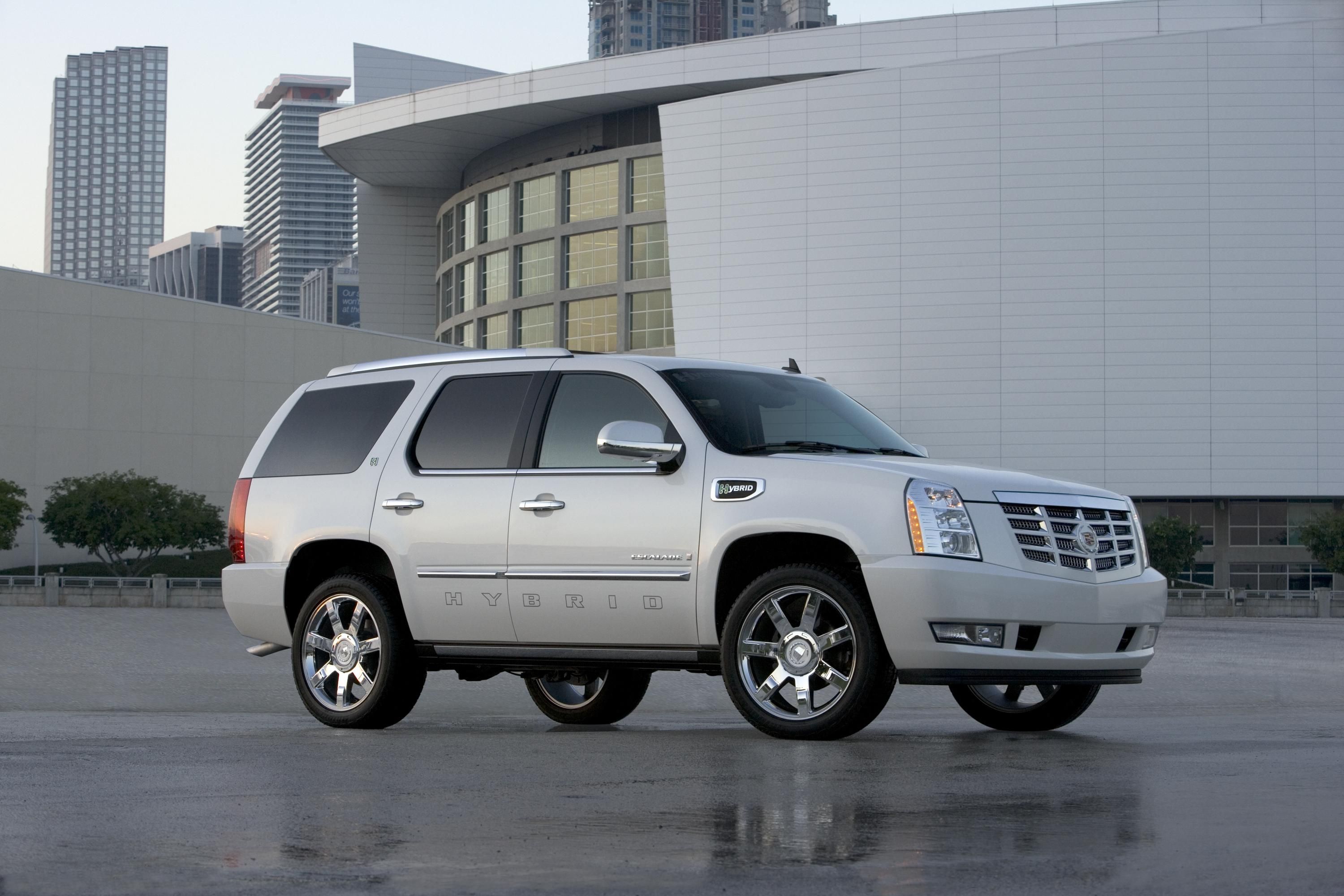 Unlike less-advanced hybrid systems, this new GM system occasionally shuts down the electric motors, allowing the EVT to function as a conventional automatic transmission. Typically, this fixed-ratio operation occurs at highway speeds or when hauling heavy loads, and can actually be more efficient than operating in electric-gasoline hybrid mode under the same conditions. This is because under high-load situations, when the fixed gears are in use, the electric motors can be used to generate electricity — or, if needed, they can be called on to supply additional torque for improved performance.
Unlike less-advanced hybrid systems, this new GM system occasionally shuts down the electric motors, allowing the EVT to function as a conventional automatic transmission. Typically, this fixed-ratio operation occurs at highway speeds or when hauling heavy loads, and can actually be more efficient than operating in electric-gasoline hybrid mode under the same conditions. This is because under high-load situations, when the fixed gears are in use, the electric motors can be used to generate electricity — or, if needed, they can be called on to supply additional torque for improved performance.
Energy Storage System (ESS)
Providing power to the EVT’s two electric motors is a 300-volt nickel-metal hydride Energy Storage System (ESS). This battery pack is located under the second-row seat, where it takes up virtually no additional space and does not interfere with second- or third-row ingress/egress.
The primary function of the ESS is to provide power (300 volts) to the EVT via the Traction Power Inverter Module (TPIM) and to store captured energy produced during regenerative braking. The ESS can also be charged, when necessary, by the gasoline engine via one of the two electric motors when operated in generator mode.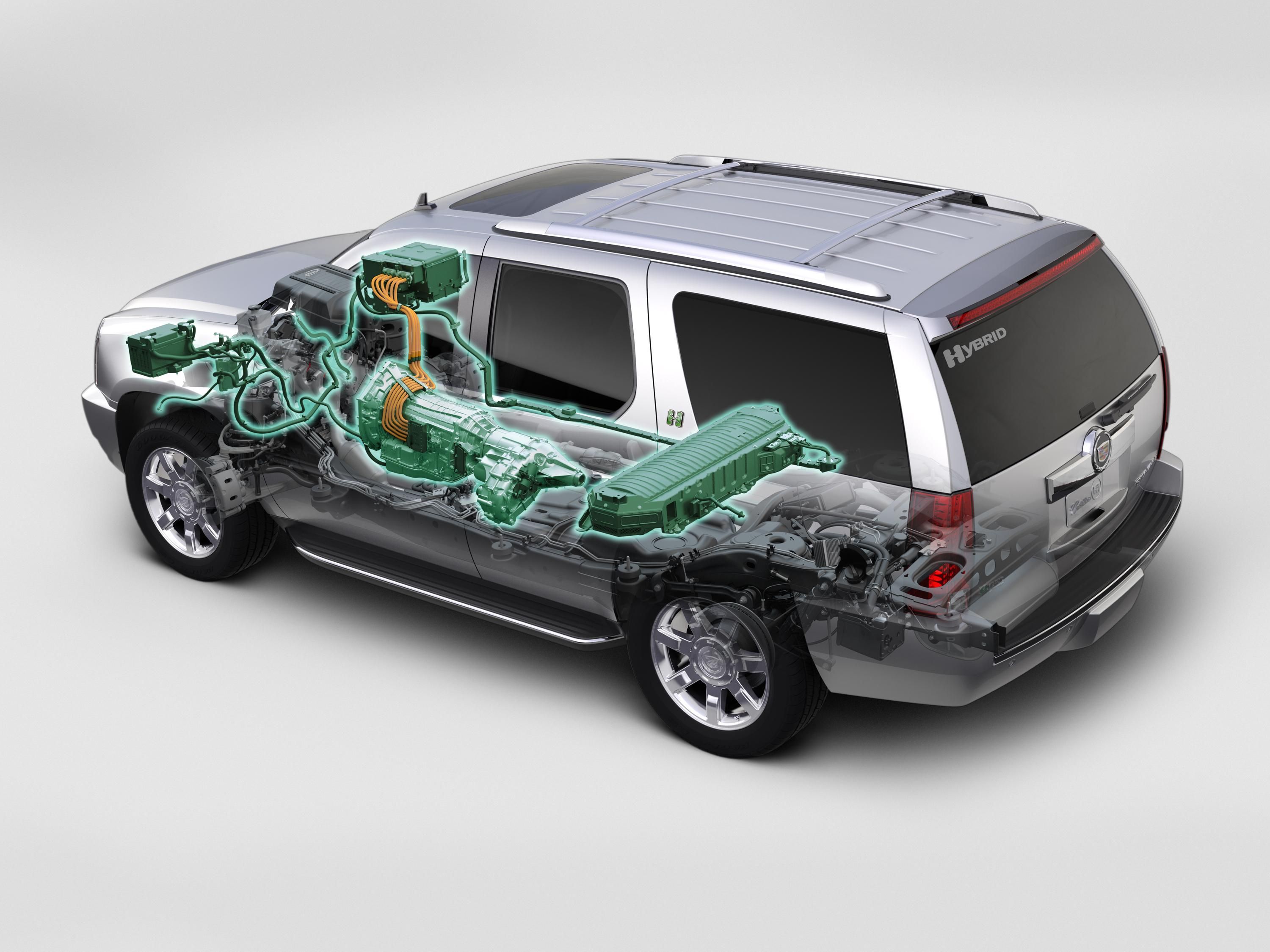 In addition to supplying power to the EVT, the ESS also provides power to the air conditioning compressor and the Accessory Power Module (APM), which converts the high-voltage supply to 42 volts for the electric power steering system, and 12 volts for the vehicle battery and other 12-volt electrical accessories.
In addition to supplying power to the EVT, the ESS also provides power to the air conditioning compressor and the Accessory Power Module (APM), which converts the high-voltage supply to 42 volts for the electric power steering system, and 12 volts for the vehicle battery and other 12-volt electrical accessories.
Battery pack durability and reliability is maintained via optimized charge and discharge cycles, as well as a dedicated cooling system that draws air from the passenger compartment. As part of the vehicle’s emission control system, the ESS is warranted for eight years/100,000 miles.
The ESS also has numerous safety features that prevent over-charging, over-heating, unintended access to high-voltage components and infiltration from liquid spills.
Regenerative braking
The Escalade Hybrid features fully blended regenerative braking to capture energy that would otherwise be lost during vehicle deceleration. By using one or both of the EVT’s traction motors as a generator, braking energy is converted to electrical energy and stored in the ESS for future use to propel the vehicle.
The regenerative brakes are used along with the standard hydraulic brakes to slow the vehicle and/or bring it to a stop. Depending on the amount of braking force required, the hydraulic brakes may not even be used, such as during mild deceleration when slowing to allow space for merging traffic near a highway on-ramp.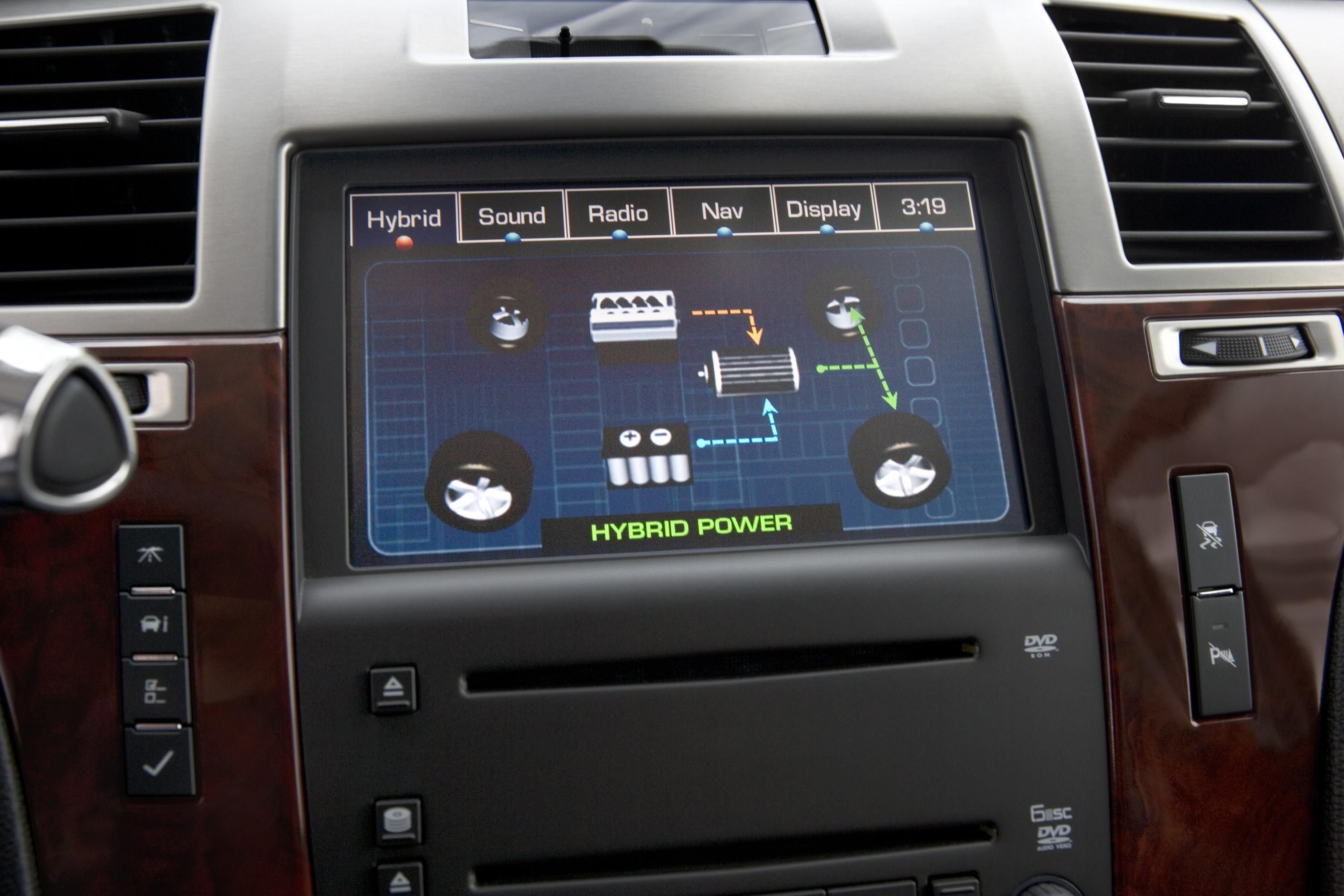 When additional braking is called for, based on a change in the position of and/or the force applied to the brake pedal emulator, the hydraulic braking system will be called on to assist the generator(s) in slowing or stopping the vehicle. The anti-lock braking system (ABS)/Electronic Stability Control (ESC) modulator used on the Escalade Hybrid has been adapted to allow this interaction between the hydraulic brakes and the regenerative braking system.
When additional braking is called for, based on a change in the position of and/or the force applied to the brake pedal emulator, the hydraulic braking system will be called on to assist the generator(s) in slowing or stopping the vehicle. The anti-lock braking system (ABS)/Electronic Stability Control (ESC) modulator used on the Escalade Hybrid has been adapted to allow this interaction between the hydraulic brakes and the regenerative braking system.
The use of cooperative control between the regenerative braking system and the hydraulic brakes results in excellent braking control and maximum energy recovery. The system also provides feedback in the form of brake pedal resistance, which gives the driver the same feel as would be experienced with a normal hydraulic braking system.
Regenerative braking has the additional benefit of extending the life of the friction materials used in the hydraulic braking system, as well as improving braking performance in the form of shorter stopping distances.
6.0L V-8 engine
The Escalade Hybrid’s 6.0L V-8 engine is unique. It features Active Fuel Management and late intake valve closing (modified Atkinson-cycle combustion process) for reduced pumping losses and better overall fuel economy.
The engine uses flat-top pistons, cylinder heads borrowed from GM’s 5.3L high-output V-8 and a 10.8:1 compression ratio, producing 332 horsepower (248 kW) at 5,100 rpm and 367 lb.-ft. of torque (497 Nm) at 4,100 rpm. It runs on regular unleaded fuel.
A key contributor to the Escalade Hybrid’s fuel economy is the gasoline engine’s Auto Stop mode. Once the vehicle reaches 0 mph, the gasoline engine is automatically shut down. By leaving the engine off and allowing the vehicle to move only under electric power, such as during heavy stop-and-go traffic, fuel consumption is greatly reduced.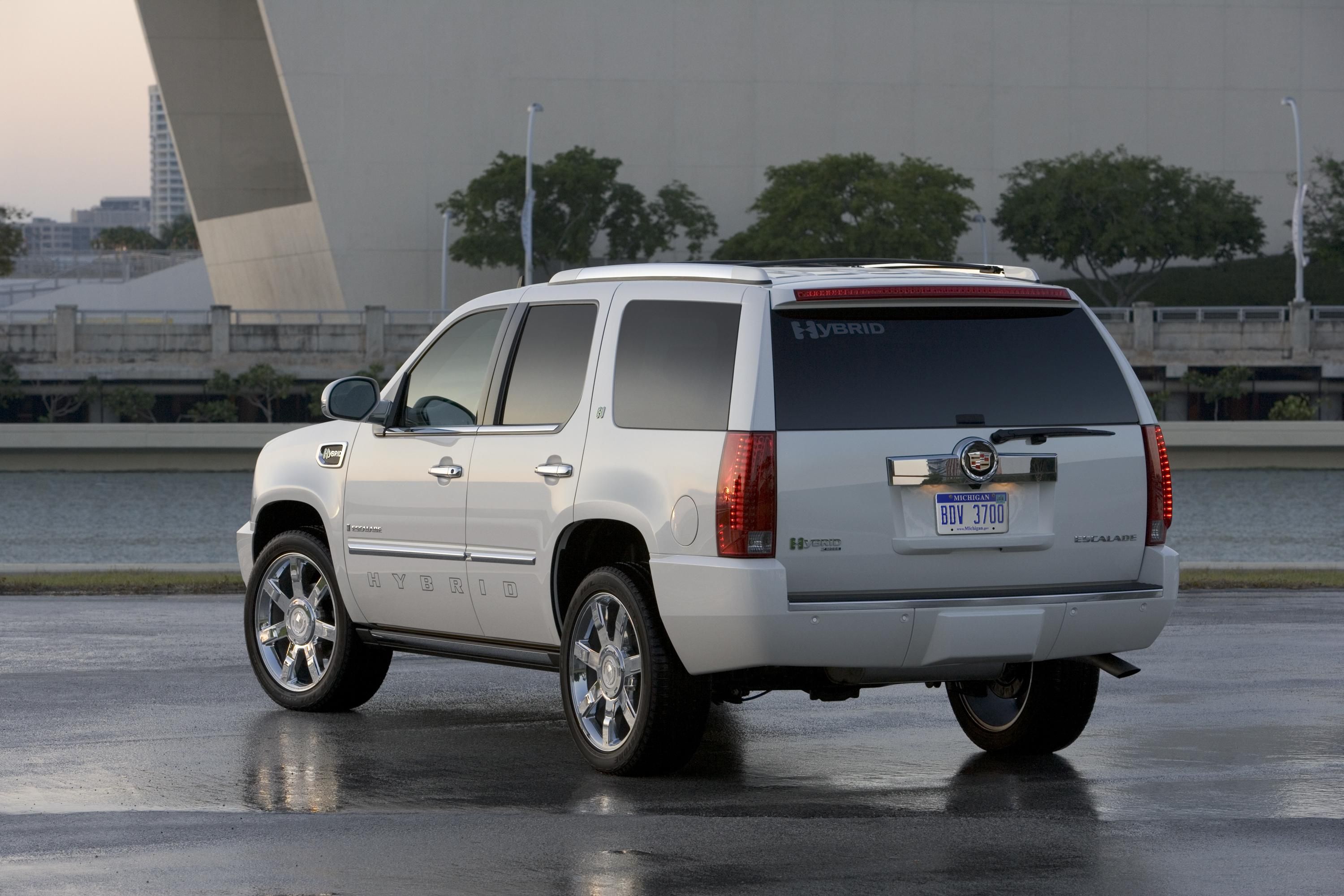 However, when extra power is required, such as for wide-open-throttle acceleration from a standing stop, the Vortec 6.0L V-8 is seamlessly restarted so it can deliver the necessary power and torque. In this case, the engine is restarted effortlessly from the Auto Stop mode using the EVT’s powerful internal electric motors; there is no traditional starter motor.
However, when extra power is required, such as for wide-open-throttle acceleration from a standing stop, the Vortec 6.0L V-8 is seamlessly restarted so it can deliver the necessary power and torque. In this case, the engine is restarted effortlessly from the Auto Stop mode using the EVT’s powerful internal electric motors; there is no traditional starter motor.

